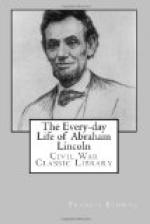the Fort, where we found the President, who was sitting
in the shade, his back against the parapet toward the
enemy.... As the firing from the Fort ceased,
our men ran to the charge and the Rebels fled.
We could see them running across the fields, seeking
the woods on the brow of the opposite hills. Below,
we could see here and there some of our own men bearing
away their wounded comrades. Occasionally a bullet
from some long-range rifle passed over our heads.
It was an interesting and exciting spectacle.”
Another account says: “President Lincoln
visited the lines in person, and refused to retire,
although urged to do so. He exposed himself freely
at Fort Stevens, and a surgeon standing alongside of
him was wounded by a ball which struck a gun and glanced.”
A gentleman named Neill, who lived in the country,
about twelve miles from the city, gives a vivid conception
of the imminence of the danger. “After
breakfast, on Tuesday, July 12,” says Mr. Neill,
“I went as usual in a railway car to the city,
and before noon my house was surrounded by General
Bradley Johnson’s insurgent cavalry, who had
made an attempt to capture the New York express train,
and had robbed the country store near by of its contents.
The presence of the cavalry stopped all travel by
railroad; and Senator Ramsey of Minnesota, who happened
to be in Washington, could find no way to the North
except by descending the Potomac to its mouth and
then ascending Chesapeake Bay to Baltimore. While
the cavalry was in the fields around my home, the
enemy’s infantry was marching toward the capital
by what was called the Seventh Street road, and they
set fire to the residence of Hon. Montgomery Blair,
who had been Postmaster-General. As I sat in my
room at the President’s, the smoke of the burning
mansion was visible; but business was transacted with
as much quietness as if the foe were hundreds of miles
distant. Mr. Fox, the assistant Secretary of the
Navy, had in a private note informed the President
that if there should be a necessity for him to leave
the city he would find a steamer in readiness at the
wharf at the foot of Sixth Street. About one
o’clock in the afternoon of each day of the skirmishing,
the President would enter his carriage, and drive
to the forts, in the suburbs, and watch the soldiers
repulse the invaders.” For several days
Washington was in great danger of capture. Nearly
all the forces had been sent forward to reinforce
Grant, and the city was comparatively defenseless.
But its slender garrison, mostly raw recruits, held
out gallantly under the encouragement of the President,
until Grant sent a column to attack Early, who promptly
withdrew, and the crisis was over. This was the
last time the enemy threatened the national capital.
From that time he had enough to do to defend Richmond.




